





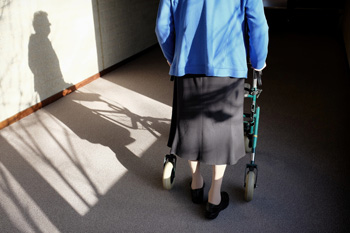
As we age, foot problems can pose significant challenges, making it harder to maintain physical activity and increasing the risk of falls. Conditions such as bunions, corns, calluses, and warts can cause discomfort and hinder mobility, impacting overall quality of life. To ensure healthy and pain-free feet, maintaining proper foot hygiene by keeping the feet clean and dry and regularly trimming toenails to prevent ingrown nails is even more important. However, seeking professional care is equally important. Regular visits to a podiatrist can help detect and address foot issues early, preventing them from worsening and reducing the risk of complications. Podiatrists can provide personalized advice on foot care, recommend appropriate footwear, and offer treatments tailored to individual needs, promoting optimal foot health and mobility in older adults. If you are elderly or taking care of someone in this age group, it is strongly suggested that you incorporate regular visits to a podiatrist into your healthcare routine.
Proper foot care is something many older adults forget to consider. If you have any concerns about your feet and ankles, contact one of our podiatrists from Active Foot and Ankle Care, LLC. Our doctors can provide the care you need to keep you pain-free and on your feet.
The Elderly and Their Feet
As we age we start to notice many changes in our body, but the elder population may not notice them right away. Medical conditions may prevent the elderly to take notice of their foot health right away. Poor vision is a lead contributor to not taking action for the elderly.
Common Conditions
Susceptible Infections
Diabetes and poor circulation can cause general loss of sensitivity over the years, turning a simple cut into a serious issue.
If you have any questions please feel free to contact our offices located in Fair Lawn, Riverdale, and Englewood, NJ . We offer the newest diagnostic and treatment technologies for all your foot and ankle needs.
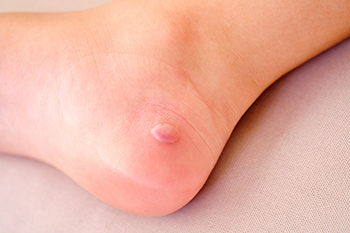 In colder weather, blisters can form on the feet due to a combination of factors related to temperature and moisture. Wearing heavy socks and shoes in the winter can lead the feet to sweat that accumulates inside your socks and shoes. This moisture, combined with reduced evaporation rates in colder temperatures, creates a damp environment around the feet. As a result, the skin becomes softer and more prone to damage from friction and rubbing against socks or shoes. Chilblains, lesions on the hands and feet that appear after exposure to the cold, can also blister. They appear within 24 hours of cold exposure and are caused by tiny blood vessels expanding too quickly once the body is exposed to heat again. If you have foot blisters after cold exposure, it is suggested you consult a podiatrist to conduct an exam and offer options to help with recurrent blister formation from chilblains.
In colder weather, blisters can form on the feet due to a combination of factors related to temperature and moisture. Wearing heavy socks and shoes in the winter can lead the feet to sweat that accumulates inside your socks and shoes. This moisture, combined with reduced evaporation rates in colder temperatures, creates a damp environment around the feet. As a result, the skin becomes softer and more prone to damage from friction and rubbing against socks or shoes. Chilblains, lesions on the hands and feet that appear after exposure to the cold, can also blister. They appear within 24 hours of cold exposure and are caused by tiny blood vessels expanding too quickly once the body is exposed to heat again. If you have foot blisters after cold exposure, it is suggested you consult a podiatrist to conduct an exam and offer options to help with recurrent blister formation from chilblains.
Blisters may appear as a single bubble or in a cluster. They can cause a lot of pain and may be filled with pus, blood, or watery serum. If your feet are hurting, contact one of our podiatrists of Active Foot and Ankle Care, LLC. Our doctors can provide the care you need to keep you pain-free and on your feet.
Foot Blisters
Foot blisters are often the result of friction. This happens due to the constant rubbing from shoes, which can lead to pain.
What Are Foot Blisters?
A foot blister is a small fluid-filled pocket that forms on the upper-most layer of the skin. Blisters are filled with clear fluid and can lead to blood drainage or pus if the area becomes infected.
Symptoms
(Blister symptoms may vary depending on what is causing them)
Prevention & Treatment
In order to prevent blisters, you should be sure to wear comfortable shoes with socks that cushion your feet and absorb sweat. Breaking a blister open may increase your chances of developing an infection. However, if your blister breaks, you should wash the area with soap and water immediately and then apply a bandage to the affected area. If your blisters cause severe pain it is important that you call your podiatrist right away.
If you have any questions, please feel free to contact our offices located in Fair Lawn, Riverdale, and Englewood, NJ . We offer the newest diagnostic and treatment technologies for all your foot care needs.
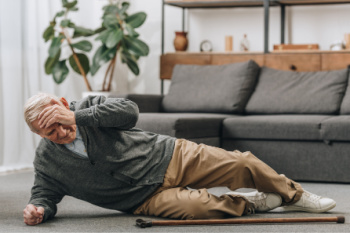
Balance is a fundamental aspect of daily life, affecting activities like walking, standing, and even tying your shoes. Recent research highlights its role in overall health, with studies revealing a correlation between poor balance and increased mortality risk. Incorporating balance exercises into your routine can lower this risk and improve stability. Here are a few exercises that aim to improve balance and reduce the likelihood of falling. It’s a good idea to have a chair or wall nearby to hold on to while performing them. The first is single-leg standing, where you elevate one leg while maintaining posture and gradually increase duration. Next is heel-to-toe walking, simulating a tightrope walk to enhance balance and coordination. Finally, integrating yoga practice can help to improve body awareness and proprioception, which is needed for equilibrium. Whether you're an athlete aiming for peak performance or an older adult with balance problems, these exercises can help reduce the risk of falls and promote overall well-being. For help with foot and ankle problems related to mobility or stability, it is suggested that you visit a podiatrist for a full exam.
Preventing falls among the elderly is very important. If you are older and have fallen or fear that you are prone to falling, consult with one of our podiatrists from Active Foot and Ankle Care, LLC. Our doctors will assess your condition and provide you with quality advice and care.
Every 11 seconds, an elderly American is being treated in an emergency room for a fall related injury. Falls are the leading cause of head and hip injuries for those 65 and older. Due to decreases in strength, balance, senses, and lack of awareness, elderly persons are very susceptible to falling. Thankfully, there are a number of things older persons can do to prevent falls.
How to Prevent Falls
Some effective methods that older persons can do to prevent falls include:
Falling can be a traumatic and embarrassing experience for elderly persons; this can make them less willing to leave the house, and less willing to talk to someone about their fears of falling. Doing such things, however, will increase the likelihood of tripping or losing one’s balance. Knowing the causes of falling and how to prevent them is the best way to mitigate the risk of serious injury.
If you have any questions, please feel free to contact our offices located in Fair Lawn, Riverdale, and Englewood, NJ . We offer the newest diagnostic and treatment technologies for all your foot care needs.
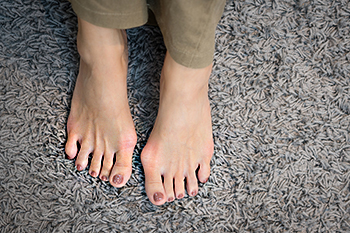
Have questions about bunion surgery and the Lapiplasty® Procedure?
How is the Lapiplasty® Procedure different?
Can I really get back on my feet quickly?
Will my bunion return?
Is it covered by insurance?
How can I find a doctor near me?
Watch our webinar on February 13th from your PC or Mac and get your questions answered by Dr. Braver, LIVE. Please also feel free to submit any questions ahead of time.
Click here to register.
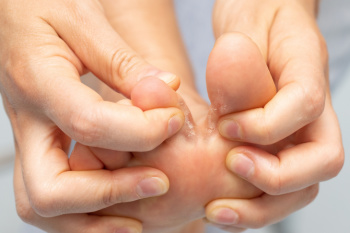 Athlete’s foot is a fungal infection that causes blisters and peeling skin on the feet. This contagious infection is generally treated with topical antifungal medications. If left untreated, athlete's foot can lead to more severe problems than the itching and redness associated with the infection. If ignored, the infection can spread to other parts of the foot, such as the toenails or the soles of the feet. As the condition progresses, it may result in painful blisters, cracks, and open sores, making daily activities like walking or standing uncomfortable. In some cases, untreated athlete's foot can contribute to the development of secondary bacterial infections, which can include swollen and painful feet. These secondary infections can also cause fever and lymph node infections. Some patients also experience allergic reactions to the initial fungal infection, causing blisters on the infected area. Podiatrists can prescribe antifungal medications and provide more information on foot hygiene to effectively quell a case of athlete’s foot. If you suspect you have athlete’s foot, it is suggested that you seek prompt treatment from a podiatrist to treat the infection and prevent it from worsening.
Athlete’s foot is a fungal infection that causes blisters and peeling skin on the feet. This contagious infection is generally treated with topical antifungal medications. If left untreated, athlete's foot can lead to more severe problems than the itching and redness associated with the infection. If ignored, the infection can spread to other parts of the foot, such as the toenails or the soles of the feet. As the condition progresses, it may result in painful blisters, cracks, and open sores, making daily activities like walking or standing uncomfortable. In some cases, untreated athlete's foot can contribute to the development of secondary bacterial infections, which can include swollen and painful feet. These secondary infections can also cause fever and lymph node infections. Some patients also experience allergic reactions to the initial fungal infection, causing blisters on the infected area. Podiatrists can prescribe antifungal medications and provide more information on foot hygiene to effectively quell a case of athlete’s foot. If you suspect you have athlete’s foot, it is suggested that you seek prompt treatment from a podiatrist to treat the infection and prevent it from worsening.
Athlete’s Foot
Athlete’s foot is often an uncomfortable condition to experience. Thankfully, podiatrists specialize in treating athlete’s foot and offer the best treatment options. If you have any questions about athlete’s foot, consult with one of our podiatrists from Active Foot and Ankle Care, LLC. Our doctors will assess your condition and provide you with quality treatment.
What Is Athlete’s Foot?
Tinea pedis, more commonly known as athlete’s foot, is a non-serious and common fungal infection of the foot. Athlete’s foot is contagious and can be contracted by touching someone who has it or infected surfaces. The most common places contaminated by it are public showers, locker rooms, and swimming pools. Once contracted, it grows on feet that are left inside moist, dark, and warm shoes and socks.
Prevention
The most effective ways to prevent athlete’s foot include:
Symptoms
Athlete’s foot initially occurs as a rash between the toes. However, if left undiagnosed, it can spread to the sides and bottom of the feet, toenails, and if touched by hand, the hands themselves. Symptoms include:
Diagnosis and Treatment
Diagnosis is quick and easy. Skin samples will be taken and either viewed under a microscope or sent to a lab for testing. Sometimes, a podiatrist can diagnose it based on simply looking at it. Once confirmed, treatment options include oral and topical antifungal medications.
If you have any questions, please feel free to contact our offices located in Fair Lawn, Riverdale, and Englewood, NJ . We offer the newest diagnostic and treatment technologies for all your foot care needs.
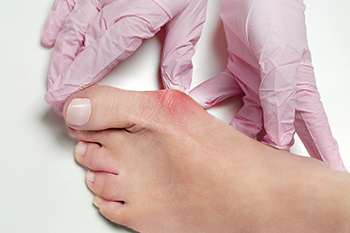
Have questions about bunion surgery and the Lapiplasty® Procedure?
How is the Lapiplasty® Procedure different?
Can I really get back on my feet quickly?
Will my bunion return?
Is it covered by insurance?
How can I find a doctor near me?
Watch our webinar on February 13th from your PC or Mac and get your questions answered by Dr. Braver, LIVE. Please also feel free to submit any questions ahead of time.
Click here to register.






